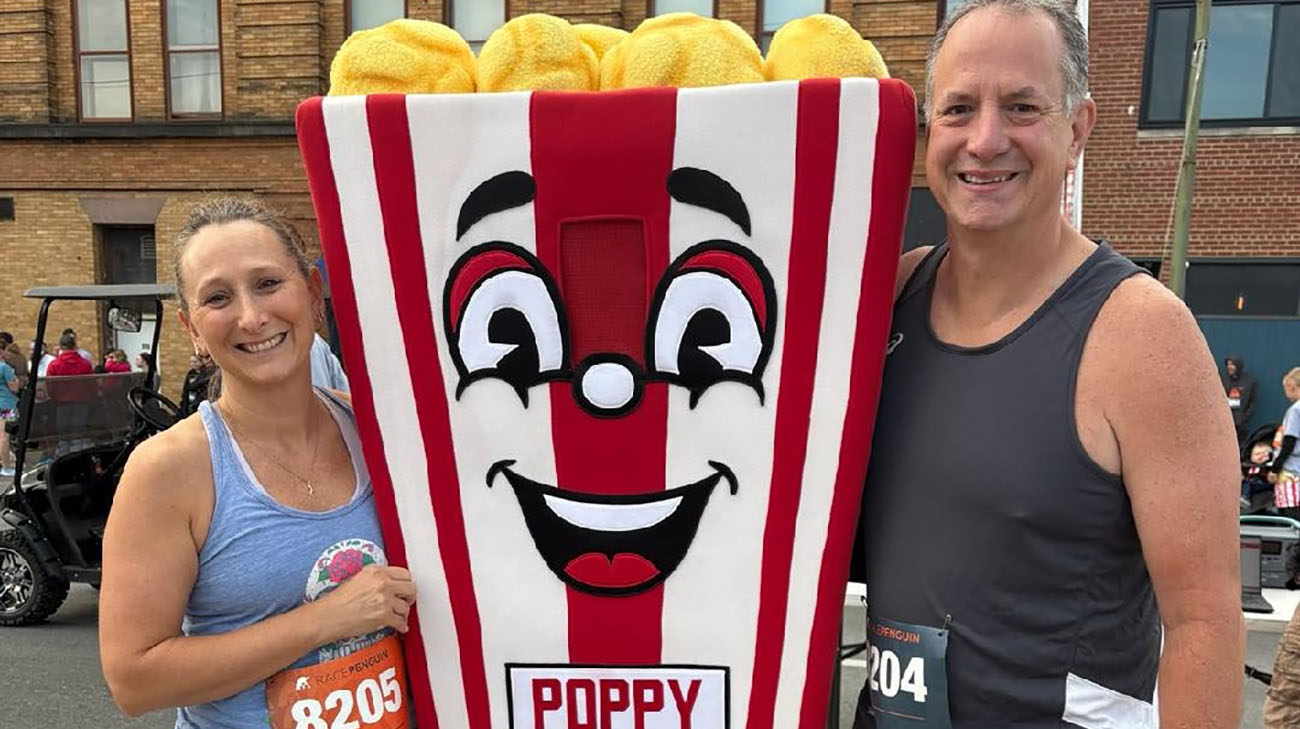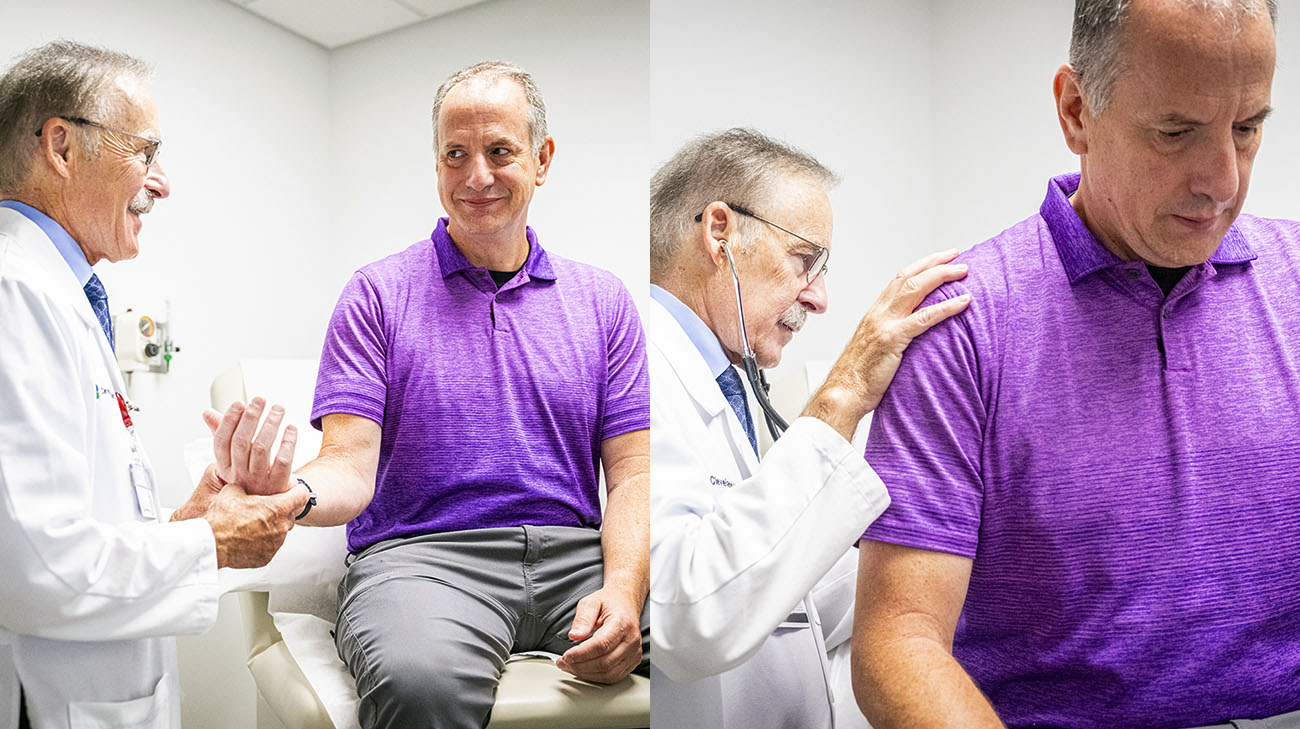
At 56 years old, Mike Roberts considered himself fit and healthy. Athletic since his college days, he enjoyed running, biking, swimming and working out “religiously,” six or seven days a week. However, in November 2024, he suddenly had stabbing pain in his lower neck and jaw while exercising.
“I went to my doctor on three occasions with the same complaints,” says Mike, a forensic scientist who lives in Mogadore, Ohio. “I knew something was wrong. My doctor told me it was TMJ (temporomandibular joint dysfunction), but I had run for 40 years, and I knew I didn’t have that. You know the difference – this was like having knives in both sides of my lower jaw and neck. When I was exercising and my heart rate was in the 120s, I would feel the pain and have to stop. If it were TMJ, I wouldn’t have had pain like that in both spots at the same time. The fact is, I know my body better than anyone else. I push it to the limit a lot. I know good pain and bad pain, and this was bad pain.”
In early March 2025, “I insisted on a neck ultrasound because when my dad was 49, he had a stroke, with three arteries blocked.” Yet, even after he received “unofficial word” that the ultrasound showed his arteries to be clear, he walked to the emergency room. There, he learned he had elevated levels of troponin, a protein found in the blood when heart muscles are damaged. This indicated that he had had a heart attack.
Mike was admitted to the hospital, where it was found that his left anterior descending artery (LAD) was completely blocked. To bypass the blockage and deliver blood to that area of his heart, his body had created its own alternative pathway, a condition known as coronary collateral circulation. He realized that this was the source of fatigue he had been experiencing for a while. “I would get tired throughout the day, no matter how much sleep I’d get,” he says. He consulted a cardiologist, who put him on a regimen of eight or nine pills. “I was told, ‘You’re good to go. We’ll see you in six months.’”
He recalled that his wife, Amy, who passed away from cancer in 2017, spoke highly of her care at Cleveland Clinic. “I remembered her telling me that she felt safe there. My first reaction was to contact Cleveland Clinic for a second opinion and look into what my possible choices were.” He met with Stephen Ellis, MD, a staff cardiologist at the Robert and Suzanne Tomsich Department of Cardiovascular Medicine.
“The other doctor had told me that I didn’t have any exercise restrictions and to keep taking the medications, but Dr. Ellis said, ‘You do have restrictions. You shouldn’t run in over 80-degree heat, you shouldn’t run in under 40-degrees, and you shouldn’t lift heavy weights.’ As much as I exercise, and at my age at the time, I thought, ‘I can’t live with restrictions. I love to run in heat and cold. I love the outdoors, and I stress my heart practically every day.’ I asked him about options.”
Dr. Ellis says that for Mike, there were three possible approaches. “The first thing is that all his risk factors have to be attended to, no matter what we do beyond that. Because of his collateral pattern, he was not likely to have a heart attack with this blockage. We could have continued to manage it with medicines, but it turned out that when he ran, he got heart pain when his heart rate was above 100. We also could have tried to open up the blockage with a stent, which might have been successful. The other option was open-heart surgery, which is the most durable way of solving the problem. The re-blockage rate of a stent within three to five years is at least 30% to 50%, but a bypass will typically last 20-plus years.”
Mike opted for open-heart surgery. In June 2025, Donna Kimmaliardjuk, MD, in Cleveland Clinic’s Department of Thoracic and Cardiovascular Surgery, performed a newer procedure, robotic-assisted coronary artery bypass grafting (CABG).
“This is a minimally invasive bypass surgery, as opposed to using a traditional incision that we do for open heart,” Dr. Kimmaliardjuk says. “When patients have a blockage in the artery on the front of the heart, it sometimes can be accessed through a 2-to-3-inch incision just under the left nipple, rather than going through the breastbone. With this patient, I used the assistance of the robot to help harvest the left internal mammary artery (LIMA), which is used to bypass the blockage on the left anterior descending artery on the front of the heart. In addition to the incision under the nipple, we make three small, keyhole incisions on the far-left side of the chest. Based on the anatomy of his blockage and other parameters, Mike was a great candidate for minimally invasive bypass.”
With this approach, recovery is faster for patients, and the visualization of the LIMA is excellent, she says. “That’s the big advantage for the patient. The robot makes visualization so much better. We can see the arteries really easily. And there is less pain for the patient after surgery because I don’t have to spread the ribs to see the artery like I would have to when I don’t use the robot.”
Blockages are caused by a buildup of cholesterol or plaque, Dr. Kimmaliardjuk says. “Over time, that can harden and calcify. We see it on an angiogram and sometimes a CT scan. With the surgery, we are bypassing the blockage. We leave it there and sew an artery or vein onto the heart past the blockage. I tell my patients that it’s like if you are driving and your GPS says there is an accident five miles ahead and traffic is at a standstill, but it can take you on an exit off the highway and down a country road past the accident and back onto the highway. You are not fixing the backup from the accident, but you are going around it.”
Dr. Ellis and Dr. Kimmaliardjuk agree that even when patients exercise, eat right, avoid smoking, and take cholesterol medication, they still can develop blockages. “Somewhere between 10 or 20 percent of patients who come to the cardiac catheterization lab for stable symptoms have total chronic occlusion of one or more of the heart arteries. His involved the LAD, which is the most important of the three major heart arteries,” Dr. Ellis says. He notes that, as in Mike’s experience, a “diagnosis of chronic total occlusion sometimes is missed. Not everybody has symptoms, and some have atypical symptoms.”

Stephen Ellis, MD checking in with Mike at a recent follow-up appointment.
To prevent heart disease, “patients should be aware of and manage their overall level of risk, including smoking, obesity and family history,” Dr. Ellis says. “For people who have one or more risk factors, they probably need a screening calcium score sometime around the age of 45. That’s a very good marker of how much old plaque sits in the heart artery.”
Although much is known about what causes heart disease, the research continues, he says. “What we know is that about one-third of these blockages are related to genetics, another third to environment – including diet, exercise and smoking – and a third that we don’t understand that well. In Mike’s case, his LDL cholesterol was 151, which is way above what it ought to be. We’d like to think that exercise is completely protective, but it’s not if your LDL cholesterol is too high. Mike changed his diet dramatically. When he gave up pop, fried foods, snacks and desserts for the most part, and took blood pressure and cholesterol medication, he dropped his LDL cholesterol by about a half. It’s not just the surgery, it’s the importance of realizing that he had one blockage and could still develop another. He needed to minimize his risk.”
Some aspects, like family genetics, cannot be modified, Dr. Kimmaliardjuk says. “And we can’t control the fact that we get older, and with that comes blockages. Also, traditionally men are at a higher risk for coronary artery disease.”
Dr. Ellis and Dr. Kimmaliardjuk say that Cleveland Clinic’s teamwork and expertise in heart care set it apart. “I’d like to think we have a very well-integrated approach,” Dr. Ellis says.
Cleveland Clinic is one of the safest places to have heart surgery, Dr. Kimmaliardjuk says. “We have excellent outcomes and great team work with cardiology, anesthesiology, nursing and the ICU.”
For Mike, everyday life has been improving since his surgery. On July 9, he and his family welcomed the birth of a grandson. He also gradually has returned to his exercise regimen, and on September 6, he completed a 5K run.
“It’s been years since I’ve felt this good,” he says. “I’m still getting my endurance up, but where I was limited before, now I’m not. Since my surgery, I’m doing three times what I could before, and I’m not stopping now!”
Related Institutes: Heart, Vascular & Thoracic Institute (Miller Family)

